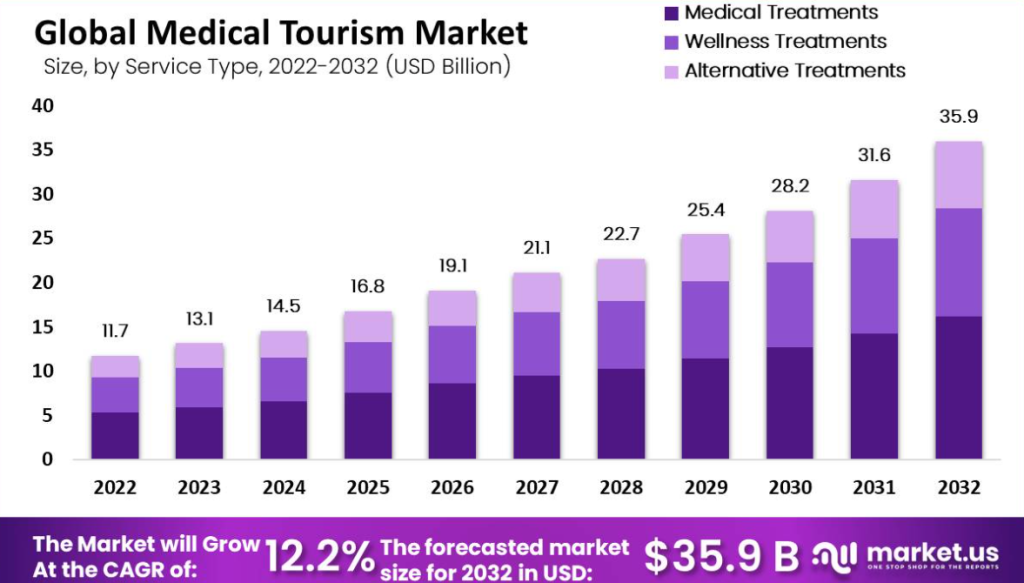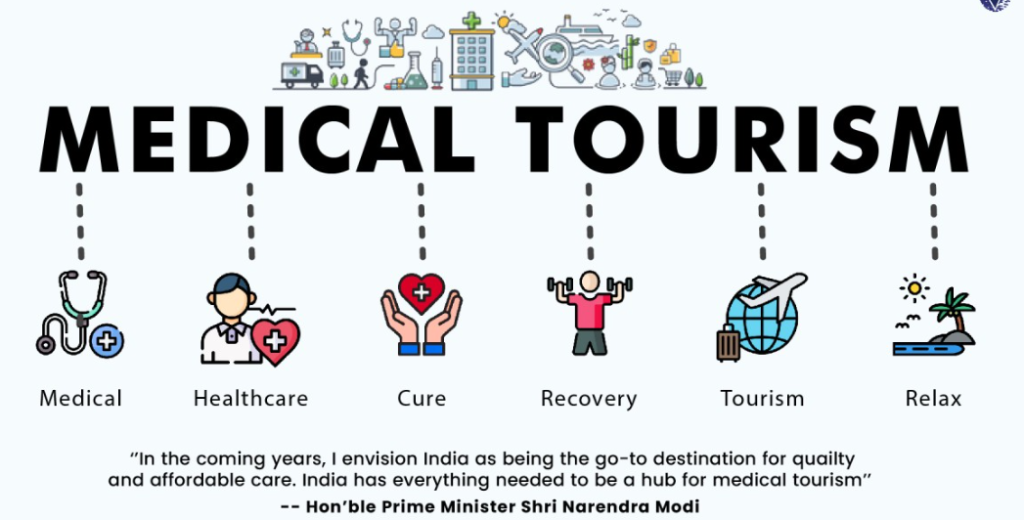1. Introduction
The global medical tourism market is experiencing rapid growth as patients seek high-quality healthcare services at affordable prices outside their home countries. This trend is reshaping the healthcare landscape, offering new opportunities for both patients and providers. From life-saving surgeries to cosmetic enhancements, people are traveling far and wide for medical treatments that can significantly improve their quality of life. This article explores the various facets of the global medical tourism market, including its drivers, challenges, and future outlook.

2. Market Overview

The medical tourism market is a multi-billion-dollar industry that has been expanding at an impressive rate. In recent years, the market has seen a surge in the number of patients traveling abroad for medical care, with countries in Asia-Pacific, Europe, and Latin America becoming popular destinations. The market is driven by the availability of advanced medical technologies, skilled healthcare professionals, and lower treatment costs compared to developed nations. Procedures such as dental care, cosmetic surgery, cardiovascular treatments, and fertility treatments are among the most sought-after by medical tourists.
3. Key Drivers of Medical Tourism
Several factors are driving the growth of medical tourism. Cost savings are a primary motivator, with treatments in countries like India, Thailand, and Mexico costing a fraction of what they would in the U.S. or Europe. Additionally, the quality of care in these countries is often on par with, if not better than, what is available in the patient’s home country. The availability of specialized treatments, shorter wait times, and the opportunity to combine medical care with travel are also significant factors contributing to the appeal of medical tourism.
4. Challenges and Barriers
Despite its growth, the medical tourism market faces several challenges. One of the primary concerns is the variability in healthcare regulations and standards between countries, which can affect the quality and safety of medical procedures. Cultural and language barriers may also complicate the patient experience, leading to misunderstandings or miscommunications during treatment. Additionally, the lack of comprehensive follow-up care and support once patients return home can result in complications or dissatisfaction with the treatment outcomes.
5. Key Players in the Market

The medical tourism market is supported by a diverse range of players, including hospitals, clinics, healthcare providers, and medical tourism agencies. Leading hospitals in countries like Singapore, Malaysia, and Turkey have developed specialized programs catering to international patients, offering everything from concierge services to translation support. Medical tourism agencies also play a critical role in connecting patients with healthcare providers, arranging travel logistics, and ensuring a seamless experience for patients.
6. Trends in Medical Tourism
The medical tourism market is constantly evolving, with new trends emerging to meet the needs and preferences of patients. One significant trend is the rise of telemedicine, which allows patients to consult with healthcare providers remotely before deciding to travel for treatment. This technology is reducing the barriers to accessing medical care abroad and is expected to play a crucial role in the future of medical tourism. Another trend is the growing popularity of wellness tourism, where patients combine medical treatments with wellness and relaxation activities, creating a holistic healthcare experience.
7. Regional Analysis
The Asia-Pacific region is the largest and fastest-growing market for medical tourism, with countries like Thailand, India, and South Korea leading the way. These countries offer a combination of affordable healthcare, skilled medical professionals, and attractive tourist destinations. In Europe, countries like Hungary, Poland, and Turkey are popular for dental and cosmetic treatments. Latin America, particularly Mexico and Costa Rica, is a preferred destination for U.S. patients due to its proximity and lower costs. The Middle East is also emerging as a medical tourism hub, with the UAE investing heavily in healthcare infrastructure to attract international patients.
8. Case Studies
Real-life examples of successful medical tourism experiences can provide valuable insights into the benefits and challenges of the market. For instance, India has become a leading destination for cardiac and orthopedic surgeries, attracting patients from around the world due to its advanced medical technology and experienced surgeons. Similarly, Thailand is renowned for its cosmetic surgery and wellness treatments, offering high-quality care in a luxurious setting. These case studies highlight the diverse opportunities within the medical tourism market and the factors that contribute to successful patient outcomes.
9. Regulatory Environment
The regulatory environment plays a critical role in the development and growth of the medical tourism market. Countries that have established robust healthcare regulations and accreditation standards, such as Singapore and Malaysia, are often more successful in attracting international patients. Accreditation bodies like the Joint Commission International (JCI) ensure that healthcare providers meet global standards of quality and safety, providing patients with confidence in the care they will receive. However, navigating different regulatory environments can be challenging for both patients and providers, requiring careful consideration and planning.
The global medical tourism market has witnessed significant growth over the past decade and is expected to continue its upward trajectory in the coming years. This growth is driven by various factors, including rising healthcare costs in developed countries, increasing demand for quality healthcare services, advancements in medical technology, and the availability of affordable treatment options in emerging economies.
Market Size and Growth Rate
- Current Market Size: The global medical tourism market was valued at approximately USD 104.68 billion in 2022.
- Forecast Period: 2023-2030
- Expected CAGR: The market is projected to grow at a compound annual growth rate (CAGR) of around 15.7% during the forecast period.
Key Growth Drivers
- Cost Advantages: Patients from developed countries, particularly the United States, Canada, and Western Europe, seek medical treatments in countries where healthcare services are significantly more affordable. Procedures such as dental work, cosmetic surgery, and elective surgeries are often available at a fraction of the cost in countries like India, Thailand, and Mexico.
- Quality of Care: Many emerging markets have made substantial investments in their healthcare infrastructure, ensuring that medical facilities meet international standards. Accredited hospitals and clinics, often staffed by internationally trained physicians, provide high-quality care, attracting patients from around the world.
- Technological Advancements: The adoption of advanced medical technologies and minimally invasive procedures in developing countries has improved the success rates of treatments, making these destinations more attractive to medical tourists.
- Aging Population: The aging population in developed countries is driving demand for various medical treatments, including orthopedic surgeries, cardiovascular procedures, and dental care. With long waiting times and high costs in their home countries, many elderly patients opt for medical tourism.
- Healthcare Access: In some regions, patients face long wait times for certain procedures or lack access to specific treatments. Medical tourism offers an alternative, allowing patients to receive timely care in another country.
- Increased Awareness: Growing awareness about medical tourism through online platforms, social media, and word-of-mouth has contributed to the market’s growth. Patients are now more informed about the options available to them globally.
Regional Insights
- Asia-Pacific: The Asia-Pacific region is expected to dominate the medical tourism market, with countries like India, Thailand, Malaysia, and Singapore leading the way. These countries offer a combination of high-quality healthcare, affordable prices, and a wide range of treatment options.
- Latin America: Countries like Mexico, Costa Rica, and Brazil are also emerging as popular medical tourism destinations, particularly for patients from the United States and Canada. The proximity to North America, along with cost-effective treatments, makes this region attractive.
- Middle East and Africa: The Middle East, particularly the UAE and Turkey, is becoming a hub for medical tourists, offering advanced healthcare services and attracting patients from neighboring regions.
- Europe: While Europe is a significant market for inbound medical tourism, countries like Hungary, Poland, and the Czech Republic are also gaining popularity as destinations for affordable dental and cosmetic procedures.
Challenges
- Regulatory Differences: Variations in medical regulations, standards of care, and accreditation processes across countries can pose challenges for patients and providers.
- Legal and Ethical Issues: Issues related to patient safety, malpractice, and legal recourse in foreign countries remain concerns for potential medical tourists.
- COVID-19 Impact: The COVID-19 pandemic had a temporary negative impact on the medical tourism industry due to travel restrictions and safety concerns. However, the market is expected to recover and grow as global travel resumes.
Future Outlook
The medical tourism market is poised for strong growth, driven by continued advancements in medical technology, increasing globalization of healthcare, and rising patient awareness. As more countries invest in their healthcare infrastructure and marketing, the competition in the medical tourism market is expected to intensify, offering patients more choices and better services. The market is also likely to see increased collaboration between governments, healthcare providers, and travel agencies to streamline the medical tourism process and enhance patient experience.
Overall, the global medical tourism market is expected to continue its robust growth, offering significant opportunities for healthcare providers, facilitators, and related industries.